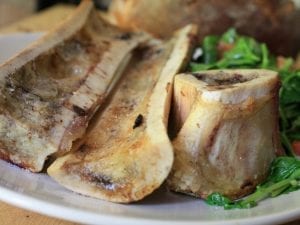
Cooking with bones and on the bone
I remember growing up at a time when bones were everywhere!
Cooking with and on the bone was the norm during the 70’s and 80’s. Now, it’s all about convenience. Mostly, our meat is presented to us boneless and conveniently packaged.
There is a saying ‘the nearer the bone the sweeter the meat’. What this means is that meat on the bone is valuable for its taste and nutrition. You get the bone marrow and other substances that enter the meat during the cooking process.
Bones are made up of minerals such as calcium, phosphorus and magnesium. When you put your mouth on a bone the saliva in your mouth dissolves some of these minerals which then enter your body. Minerals keep your body healthy. So, if you are short on minerals then eat meat next to the bone.
Bones also contain marrow. This is a fatty substance yet full of nutrients and is really valuable to making your bones strong and healthy. Bone marrow is released into the meat during the cooking process making the meat more nutritious and sweeter.
When you cook with meat on the bone the marrow and other substances from the bones actually flavour the meat adding a character and depth of taste that you just don’t get with boneless cuts.
Examples of how you can use bones:
Cook bone – in cuts: These are cuts of meat that still have the bone attached.
When making stocks: There are plenty of ready made stocks out there. However, if you can make your own stock you will have a much better product. Here’s why:
Aside from the benefits already mentioned, using bones on the joints of other bones means that there is plenty of cartilage. When you cook the stock on a low heat for a long time, the cartilage converts to gelatine which is terrific as it adds to the depth and character of the stock. This is so important because this contributes enormously to the quality of your stock. In the culinary world stocks are important because your ability to make terrific sauces, soups and braised dishes can largely depend on your ability to make a quality stock.
When making braised dishes: I make braised dishes all the time. If you don’t have the time to make stock then by all means purchase it and you can make up for the gelatine factor (and the other health benefits of what bones give to stocks) by braising bone in meat cuts. I braise beef or veal osso busso. This comes from the shank and sliced across the bone. As with the stock, during the long slow cooking in the oven the cartilage in the osso bucco bones slowly convert to gelatine which dissipate into the meat (that surround the bones) and into the sauce. This is why such a braised dish is just so delicious, healthy and full of character.
There is marrow in all animal bones but the shank bones of beef and veal hold quite a high proportion of marrow.
Bones and bone in meat cuts are natural and authentic. This is where you pick up a lot of benefits in your cooking. So, go to your local or favourite butcher buy bones and bone – in cuts and make them part and parcel of your culinary repertoire.
Your Meat Mate explains this and a whole lot more!
